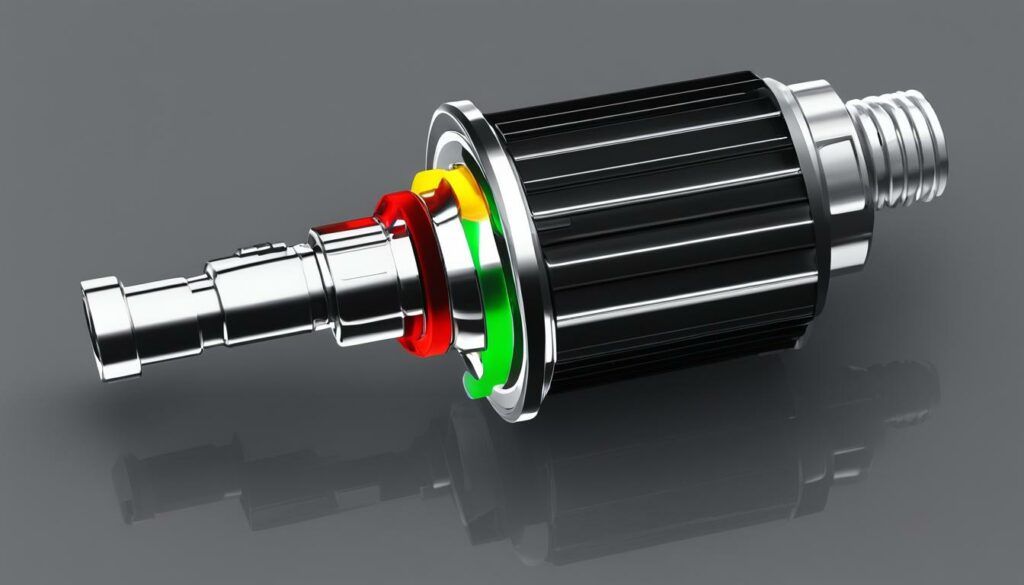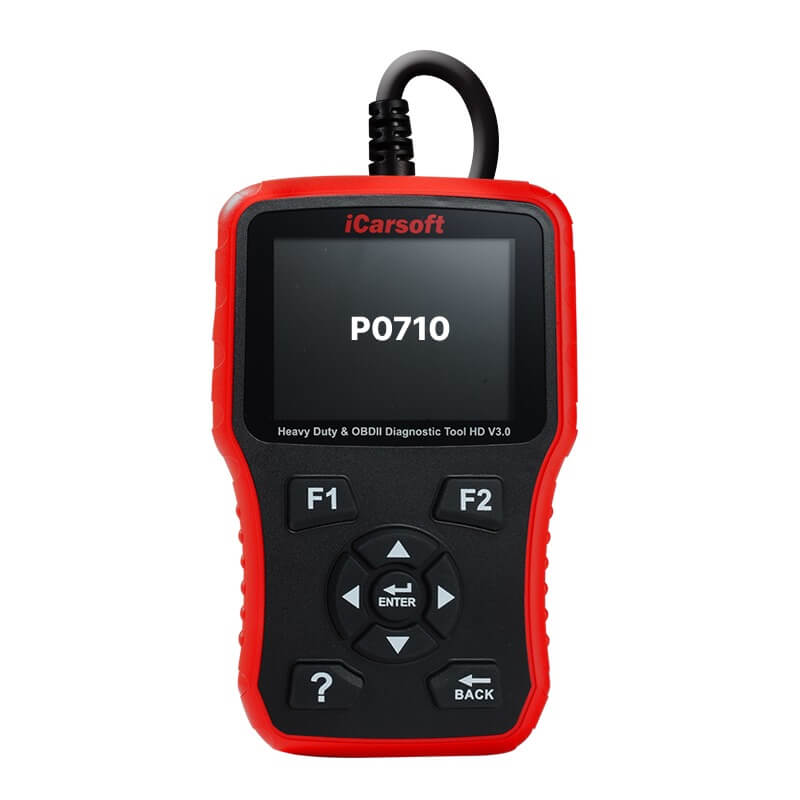P0710 – Transmission Fluid Temperature Sensor Circuit Malfunction
POSTED IN pcodes
Are you experiencing issues with your vehicle’s transmission? One possible culprit could be a malfunctioning transmission fluid temperature sensor. In this article, we will explore the P0710 code, which indicates a circuit malfunction in the transmission fluid temperature sensor. Understanding this code and its symptoms is crucial for ensuring proper diagnosis and repair.
Key Takeaways:
- The P0710 code indicates a malfunction in the transmission fluid temperature sensor circuit.
- This code can cause symptoms such as an illuminated check engine light, improper torque converter clutch operation, harsh or delayed shifts, or the vehicle being stuck in limp mode.
- Common causes for this code include a faulty transmission fluid temperature sensor, transmission problems, wiring problems, or a faulty PCM.
- Diagnostic and repair procedures involve visually inspecting the sensor and wiring, testing the sensor, and checking the circuit.
- Addressing the P0710 code promptly is essential to prevent further transmission issues and ensure proper vehicle performance.
Understanding the Transmission Fluid Temperature Sensor
The transmission fluid temperature sensor (TFT) plays a crucial role in the vehicle’s transmission system. It is typically located in the transmission oil pan and is responsible for measuring the temperature of the transmission fluid.
The TFT sensor utilizes a reference voltage from the powertrain control module (PCM) and adjusts its internal resistance based on the fluid temperature. It is classified as a negative temperature coefficient (NTC) thermistor, meaning its internal resistance varies inversely with the oil temperature. As the transmission fluid temperature rises, the resistance of the TFT sensor decreases, and vice versa.
This signal is then relayed back to the PCM, assisting in determining shift points, line pressure, and torque converter clutch control. The PCM utilizes the information provided by the TFT sensor to optimize the performance and efficiency of the transmission system.

Buy tested tuning file for Adblue / EGR / DPF / Adblue off now!
By constantly monitoring and adjusting to the fluid temperature, the TFT sensor ensures that the transmission operates within the optimal temperature range, promoting smoother shifts and improved overall performance.
Symptoms of P0710 – Transmission Fluid Temperature Sensor Circuit Malfunction
When the P0710 code is present, it can manifest in various symptoms related to the transmission. It’s important to address this code as soon as possible to prevent further transmission issues and potential damage. Some of the common symptoms associated with P0710 are:
- Check engine light: An illuminated check engine light on the dashboard is often one of the first signs of a P0710 code. This indicates that the vehicle’s onboard diagnostic system has detected an issue with the transmission fluid temperature sensor circuit.
- Torque converter clutch operation: A malfunctioning transmission fluid temperature sensor can affect the operation of the torque converter clutch. This can result in improper engagement or disengagement of the clutch, leading to issues with the vehicle’s acceleration and overall performance.
- Harsh or delayed shifts: The P0710 code can cause the transmission to experience harsh or delayed shifts. You may notice a sudden jolt when shifting between gears, or a delay in the transmission’s response when accelerating or decelerating.
- Limp mode: In some cases, the vehicle may go into limp mode when the P0710 code is triggered. Limp mode is a failsafe mechanism designed to protect the transmission from further damage. When in limp mode, the vehicle may have limited power and will typically only operate in one or two gears.
Experiencing any of these symptoms can be a clear indication of a transmission malfunction. It’s crucial to seek professional assistance or perform the necessary diagnostics and repairs to address the P0710 code promptly.
“Experiencing symptoms like a check engine light, improper torque converter clutch operation, harsh or delayed shifts, or the vehicle being stuck in limp mode can all indicate a P0710 code, signaling a malfunction in the transmission fluid temperature sensor circuit.”

It’s important to note that while these symptoms are commonly associated with P0710, they can also be indicative of other transmission issues. Therefore, proper diagnostics are essential to accurately identify and resolve the underlying problem.
Comparison of Symptoms
| Symptoms | P0710 – Transmission Fluid Temperature Sensor Circuit Malfunction | Other Transmission Issues |
|---|---|---|
| Check engine light | ✓ | |
| Torque converter clutch operation | ✓ | |
| Harsh or delayed shifts | ✓ | |
| Limp mode | ✓ |
Table: A comparison of symptoms commonly associated with P0710 – Transmission Fluid Temperature Sensor Circuit Malfunction and other transmission issues. While P0710 exhibits these symptoms, they may also be present in other transmission-related problems. A proper diagnosis is necessary for accurate identification of the underlying issue.
Common Causes of P0710 – Transmission Fluid Temperature Sensor Circuit Malfunction
The P0710 code can be triggered by several common causes. This includes a faulty transmission fluid temperature sensor, which may have internal issues affecting its resistance and accuracy. Other causes can include general transmission problems, such as mechanical issues or fluid contamination, wiring problems such as loose connections or damaged wires, or a faulty PCM that is not receiving or interpreting the sensor’s signals correctly.
| Cause | Description |
|---|---|
| Faulty Transmission Fluid Temperature Sensor | A faulty sensor can lead to improper readings, affecting the transmission’s performance and triggering the P0710 code. |
| Transmission Problems | Mechanical issues or fluid contamination within the transmission can interfere with the sensor’s operation and cause the code to appear. |
| Wiring Problems | Loose connections or damaged wires in the sensor circuit can disrupt the transmission fluid temperature signal, resulting in the code. |
| Faulty PCM | If the powertrain control module (PCM) responsible for receiving and interpreting the sensor’s signals is faulty, it may lead to the P0710 code. |
A faulty transmission fluid temperature sensor, general transmission problems, wiring issues, or a faulty PCM can all contribute to the appearance of the P0710 code.
Diagnostic and Repair Procedures for P0710 – Transmission Fluid Temperature Sensor Circuit Malfunction
When dealing with the P0710 code, it’s important to follow a systematic approach to diagnose and repair the transmission fluid temperature sensor circuit malfunction. The following steps outline the recommended troubleshooting process:
Step 1: Visual Inspection
Begin by visually inspecting the transmission fluid temperature sensor and the corresponding wiring for any signs of damage or loose connections. Look for frayed wires, corrosion, or physical damage to the sensor. If any issues are identified, repair or replace the faulty components as necessary.
Step 2: Clearing the Code
After addressing any visible damage, clear the P0710 code from the PCM and observe if it returns. This step helps determine if the repair successfully resolved the circuit malfunction or if further diagnostics are required.
Step 3: Technical Service Bulletins (TSBs)
Check for any technical service bulletins (TSBs) related to the P0710 code specifically. TSBs often provide valuable insights and guidance for resolving common issues associated with this code. Implement any recommended procedures or repairs outlined in the TSBs.
Step 4: Circuit Testing
Perform circuit testing to ensure proper connections and voltages within the transmission fluid temperature sensor circuit. Use a multimeter to measure voltage and resistance at various points in the circuit. Compare the measured values with the manufacturer’s specifications to identify any discrepancies. This step helps identify potential faults in the wiring or the sensor circuit.
Step 5: Sensor Testing
Test the transmission fluid temperature sensor for accurate resistance changes with temperature. Remove the sensor from the transmission and heat it gradually while monitoring its resistance values. Compare the measured resistance values with the manufacturer’s specifications to check for accuracy. Any deviations may indicate a faulty sensor that needs to be replaced.
Step 6: Ground Check
Verify the grounding of the transmission fluid temperature sensor circuit. Use a multimeter to test continuity between the sensor’s ground wire and a known good ground point. Ensure there is a reliable connection and no excessive resistance. A poor ground can disrupt the sensor’s operation and lead to circuit malfunctions.
Step 7: PCM Check
Finally, perform a comprehensive check of the powertrain control module (PCM) responsible for receiving and interpreting the signals from the transmission fluid temperature sensor. Test all relevant circuits and inputs to ensure the PCM is functioning correctly. If necessary, consult the manufacturer’s diagnostic procedures for further guidance on PCM testing and potential repairs.
By following these diagnostic and repair procedures, you can effectively troubleshoot and resolve the P0710 code – transmission fluid temperature sensor circuit malfunction. Keep in mind that the specific steps and test values may vary depending on the make, model, and year of the vehicle. Consulting the appropriate service manual or seeking professional assistance may be necessary for accurate and efficient repairs.
Avoiding Common Mistakes When Diagnosing P0710 – Transmission Fluid Temperature Sensor Circuit Malfunction
When dealing with the P0710 code and diagnosing a transmission fluid temperature sensor circuit malfunction, it’s crucial to be aware of common mistakes that can hinder the troubleshooting process. By avoiding these mistakes, you can save time and effort while effectively resolving the issue.
- Failure to Clear the Code: One of the most common mistakes is neglecting to clear the code and reset the engine computer after addressing a previous issue. It is essential to clear the code once the problem has been fixed, as the code may still be stored. Failing to clear the code can lead to confusion and unnecessary troubleshooting.
- Skipping Fluid Check: Another common mistake is overlooking the importance of checking the transmission fluid level and condition. Low or dirty fluid can cause similar symptoms to a transmission fluid temperature sensor circuit malfunction. Therefore, it is critical to inspect the fluid to ensure it is at the appropriate level and free from contaminants.
By taking care to avoid these common mistakes, you can streamline the diagnostic process and accurately address the P0710 code. Don’t overlook the importance of clearing the code and checking the transmission fluid as part of your troubleshooting efforts.
Importance of Addressing P0710 – Transmission Fluid Temperature Sensor Circuit Malfunction
Addressing the P0710 code promptly is essential to prevent further transmission issues. Ignoring the code can lead to more severe problems and potentially costly repairs. Early detection and maintenance can help ensure the longevity and proper functioning of the transmission. Proper repair and resolution of the code can also restore the vehicle’s performance and drivability.
When the P0710 code is detected, it is crucial to take immediate action. By addressing the issue promptly, you can prevent additional damage to the transmission system. Transmission issues can range from inconvenient and costly repairs to complete transmission failure. Early detection allows for timely intervention, helping to avoid more severe and expensive problems down the line.
Regular transmission maintenance is also essential for the overall health of your vehicle. Following manufacturer-recommended maintenance schedules and conducting regular inspections can help identify potential issues before they worsen. By keeping up with transmission maintenance, you can prolong the lifespan of your vehicle’s transmission and improve its performance.
Resolving the P0710 code not only prevents further complications but also restores the vehicle’s performance and drivability. When the transmission functions optimally, you can enjoy a smooth and responsive driving experience. Ignoring the code can lead to sluggish acceleration, harsh shifting, and reduced fuel efficiency, negatively impacting your overall driving experience.
Addressing the P0710 code promptly and seeking professional repair when necessary is crucial for maintaining the overall health and performance of your vehicle. Don’t delay in taking action when faced with a transmission issue, as early detection and proper repair can save you time, money, and unnecessary frustrations.
Conclusion
In conclusion, the P0710 code indicates a malfunction in the transmission fluid temperature sensor circuit. This issue should be addressed promptly to prevent further transmission problems. It is crucial to follow the diagnostic and repair procedures, which include visually inspecting the sensor and wiring, testing the sensor and circuit, and checking for proper grounds.
Furthermore, it is important to avoid common mistakes such as failing to clear the code and neglecting to check the transmission fluid level and condition. These troubleshooting tips can contribute to a more efficient diagnosis of the problem.
By addressing the P0710 code in a timely manner, you can ensure proper transmission maintenance and restore optimal vehicle performance. However, if professional assistance is not readily available, an alternative solution may involve permanently removing this specific code by uploading the Engine Control Unit (ECU) file to a dedicated portal.
FAQ
What is the P0710 code?
The P0710 code is a generic powertrain code that indicates a malfunction in the transmission fluid temperature sensor circuit.
What does the transmission fluid temperature sensor do?
The transmission fluid temperature sensor (TFT) is responsible for sending a signal to the powertrain control module (PCM) to determine shift points, line pressure, and torque converter clutch control.
What are the symptoms of the P0710 code?
Symptoms may include an illuminated check engine light, improper torque converter clutch operation, harsh or delayed shifts, or the vehicle being stuck in limp mode.
What are the common causes of the P0710 code?
Common causes include a faulty transmission fluid temperature sensor, transmission problems, wiring problems, or a faulty PCM.
How is the P0710 code diagnosed and repaired?
Diagnostic procedures involve visually inspecting the sensor and wiring, testing the sensor and circuit, and checking for proper grounds. If necessary, components may need to be replaced.
What are common mistakes to avoid when diagnosing the P0710 code?
Common mistakes include not clearing the code and resetting the engine computer after resolving a previous issue and not checking the transmission fluid level and condition.
Why is it important to address the P0710 code?
Ignoring the code can lead to more severe transmission issues and potentially costly repairs. Addressing it promptly helps ensure proper transmission maintenance and restores vehicle performance.
What is the conclusion for P0710 – Transmission Fluid Temperature Sensor Circuit Malfunction?
By addressing the P0710 code promptly, you can ensure proper transmission maintenance and restore vehicle performance. Following proper diagnostic and repair procedures is crucial for resolving the issue and preventing further transmission issues.


